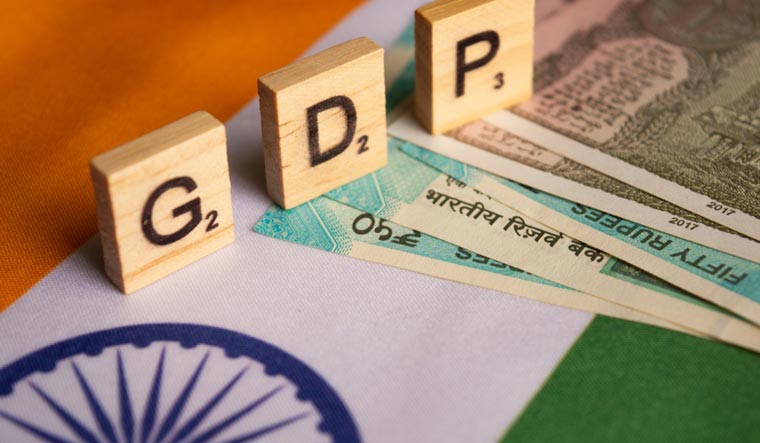India’s latest GDP figures show the growth rate stalling to 3.1 per cent in Q4 of 2020 for the January-March quarter, while growth for the FY20 financial year is placed at 4.2 per cent—a drop from 6.9 per cent in FY19.
At 4.2 per cent, FY20's growth rate is the lowest in 11 years.
While the impact of COVID-19 was felt only in Q4, the economy was witnessing a slowdown from the beginning of the financial year, as GDP growth in Q1 was 5 per cent, Q2 was 4.5 per cent and Q3 was 4.7 per cent.
According to the Ministry of Statistics and Programme Implementation, “Real GDP or Gross Domestic Product (GDP) at Constant (2011-12) Prices in the year 2019-20 is now estimated to attain a level of Rs 145.66 lakh crore, as against the First Revised Estimate of GDP for the year 2018-19 of Rs139.81 lakh crore, released on 31st January 2020. The growth in GDP during 2019-20 is estimated at 4.2 percent as compared to 6.1 percent in 2018-19."
"GDP at Current Prices in the year 2019-20 is estimated to attain a level of ₹ 203.40 lakh crore, as against the First Revised Estimates of ₹ 189.71 lakh crore in 2018-19, showing a growth rate of 7.2 percent as compared to 11.0 percent in 2018-19," the government said in a press release.
MOSPI added that per capita income in real terms had grown by 3.1 per cent in FY20.
“The Per Capita Income in real terms (at 2011-12 Prices) during 2019-20 is estimated to attain a level of Rs 94,954 as compared to Rs 92,085 in the year 2018-19, resulting in growth of 3.1 percent during 2019-20, as against 4.8 per cent in the previous year. The Per Capita Income at current prices during 2019-20 is estimated to be Rs 134,226, showing a rise of 6.1 percent as compared to ₹ 1,26,521 during 2018-19.”
Likewise, GDP at constant prices (2011-12) grew by 3.1 per cent in Q4, from Rs 36.90 lakh crore to Rs 38.04 lakh crore.
Gross value added—a key input of GDP that strips out taxes—grew 3 per cent in the January-March quarter from a year ago.
The data comes as core sector output also dropped 38 per cent in April due to the nationwide lockdown, compared to growth of 5.2 per cent the previous year.
The services sector accounts, which accounts for 55 per cent of gross domestic product (GDP), and manufacturing has been severely crippled by the lockdown, causing ripple effects on jobs and economic growth.
Slower economic growth also meant slippage in fiscal deficit target. Fiscal deficit—the shortfall in a government's income compared with its spending—came in at 4.59 per cent of GDP for FY20, as compared to the budgetary target of 3.8 per cent.
Commenting on the GDP numbers, Rumki Majumdar, Economist, Deloitte India, said growth in the last quarter of FY20 has been the slowest since the global financial crisis more than a decade ago.
"If one may recollect, economic activities were showing signs of traction in early 2020. India's industrial production for the first two months suggested that green shoots were appearing in industrial activities.
"In other words, a large part of the slowdown that we see in the January-March quarter may have happened primarily in the second half of March, which is when COVID-19 started spreading aggressively in India forcing the government to take immediate actions to contain the spread," she said.
She said this implies that India's growth may have been on a stronger track had there been no COVID-19 and that fundamentals were improving.
"While one can gauge the extent of the impact two weeks of disruption has caused and that more pain awaits in the first quarter of the new fiscal year, which is when the disruption is likely to be the maximum, India may see a quicker recovery when this pandemic subsides," she said, adding several fundamentals remain strong and low oil prices will help.
S&P had on Thursday stated that economic activity will face ongoing disruption over the next year as the country transitions to a post-COVID-19 world.
To deal with the economic fallout of COVID-19, the government announced a Rs 20.9 lakh crore package, mostly made up of subsidised credit to small businesses and farmers with direct fiscal stimulus limited to around 1 per cent of the GDP.
The Reserve Bank of India (RBI) has reduced the key interest rate by 115 basis points since March. The RBI had also pegged the GDP growth for 2019-20 at 5 per cent.
The services sector was among the hardest hit by the lockdown restrictions imposed since March 25. Trade, hotels, and transport grew 2.6 per cent in the January-March quarter from a year ago, while financial services expanded 2.4 per cent.
With inputs from PTI


